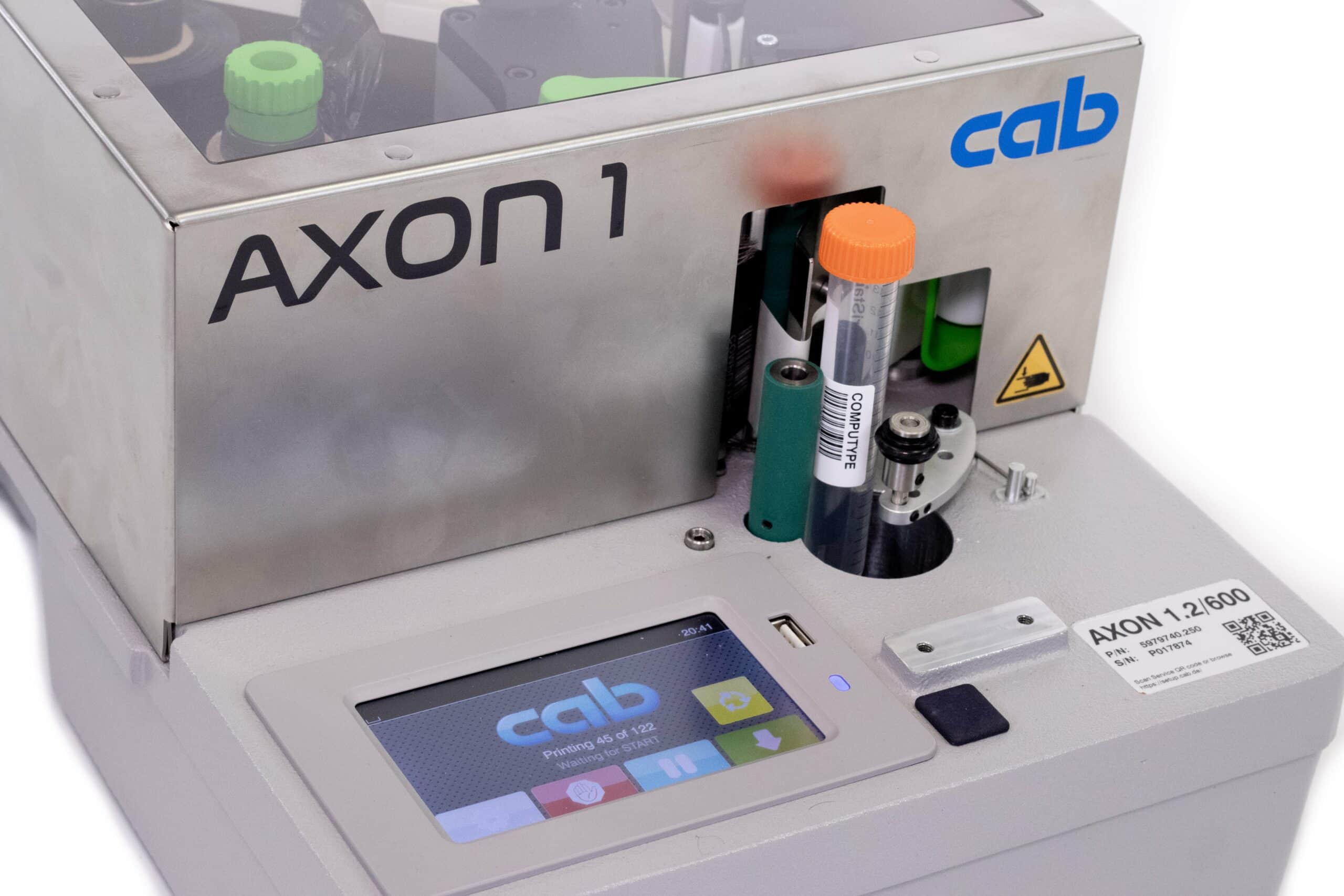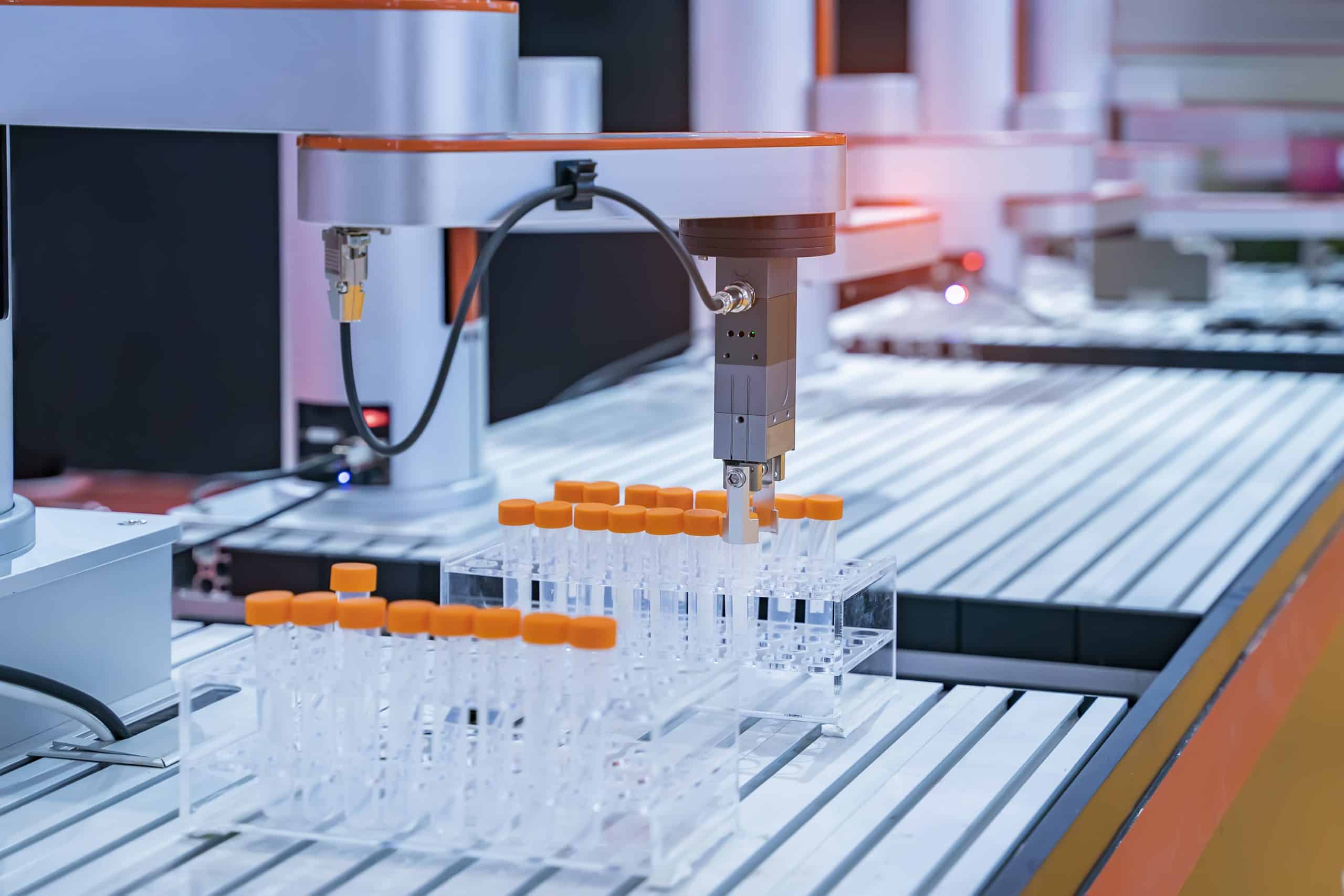In today’s fast-paced world, laboratories seek out automated processes and workflows more frequently than ever—for a good reason. Automating any process provides tangible business benefits through increased throughput, accuracy, consistency, and improved control. The question often becomes, how much of a process can and should be automated, and at what point do integrations make sense?
While processes like liquid handling, pipetting, or even diagnostic staining commonly already utilize automation in the healthcare industry, laboratories often overlook subsequent or supporting processes like labeling and barcoding when planning for workflow automation. As a result, many facilities are forced to either retrofit barcode labeling systems or manually apply labels, which can counteract some of the benefits achieved during prior automated processing.
Making barcode labeling a priority in your laboratory and thinking through your workflow holistically upfront can benefit your automation integration process in several ways. A strategic approach can ensure complete optimization of the time, budget, and physical space needed for automation.
We paired up with our automation partners at PaR Systems to compile this list of our top 10 considerations when considering your automation plan.
1. Consider the complete picture of your laboratory testing procedures and research goals.
Designing an automated, barcode-optimized, data-driven laboratory requires a comprehensive audit of your needs.
It can be hard to figure out where to start when planning an automation strategy—the only real place to start is right here and now.
Paint a picture of your processes from start to finish and look at it from a strategic perspective—from opening bulk labware through delivery to your end user. Look for areas in your workflows where things are flowing smoothly and identify any bottlenecks. If you are considering automation, likely, you have already done this to some degree.
Think about the effect these areas have on your processes and product. Are operators hand-picking and placing every vial to be labeled? Are operators visually inspecting every label for readability? From there, you will want to define what success would look like. What would make it successful if you built and implemented a system to address these pain points?
Clarifying both your initial problem and your vision of future success from the beginning will not only address the issue but also guide the entire project towards overall success.
2. Take a detailed look at your product lifecycle and map out your lab’s workflows.
Evaluate the digital and physical lifecycle of your laboratory’s samples, specimens, compounds, and other critical assets.
What does the entire lifecycle of your product look like? Your labware will go through a lot from the beginning of your workflow to the end-user.
Making sure it is prepared for each step along the way from the beginning will optimize efficiency and user-friendliness at every stage.
Build a map of your workflows.
What does your product look like at the very beginning? Where does each workflow occur?
Where do they come together, and how?
Are pieces moving through an automated process? A manual one?
Taking an objective view of how your product flows through your systems will highlight areas of improvement and the most effective ways to make those improvements.
Another key consideration when reflecting on your process is product feeding. Whether labware is fed manually or automatically to and from your equipment will significantly impact your overall solution in various ways.
You will need to ensure the dimensions, software, product input, and output suit your existing systems. What happens next? Who is using your product? How is it being used? Keeping in mind that the point of use may be outside your facility, you will want to ensure your product is prepared to perform optimally for everyone who comes into contact with it.
Consider any special requirements your containers may need to meet—regulatory, physical, data, etc. Your labware and barcodes may need to survive extreme conditions, meet legal requirements, or present in a specific way.
Regarding label automation, a key consideration at this point is label construction. You may use a specific label because it can withstand certain chemical exposures or conditions.
Not every label is suitable for automation for various reasons, so you may need to plan to alter your label strategy in order to accommodate both your new equipment and existing use requirements.
Not only do you need to consider these factors in your label’s construction to avoid negatively impacting use requirements—but you may be able to identify opportunities to improve the experience for your end users.
For example, let us say you are preparing tubes for a test that requires two tubes. We can design the automation to place tubes in sets of two in a rack. Or, maybe each workstation in a lab will process fourteen samples at a time. Your automation system could sort and rack containers into groups of fourteen.
When you keep your product’s entire life cycle in mind throughout your automation system’s planning, you can prepare your labware for later steps in processing and use it early on in your processes. This preparation can be beneficial when end-users are outside of your facility. By integrating their needs into your systems, you pass the benefits of your automation onto them, improving their experience with your product and building trust.
3. Set big-picture goals for laboratory efficiency and quality improvements.
Laboratory barcoding and automation can improve more than just label application. Create value for your business with widespread improvements.
Even more than the equipment or labeled containers themselves, think about the quality improvements resulting from an automated process. One of the main reasons laboratories want to implement automation in the first place is for time and resource savings, especially when it comes to labeling since it is such a laborious and tedious task.
Freeing up employee time and hands, as well as real estate, is incredibly valuable—but consider what to do with those available resources.
Your employees are skilled professionals, and with reduced effort in preparatory work, they will have time to focus directly on tasks that impact your mission.
Another benefit to your employees is the ergonomic gains. Now that you have the equipment to take on the more tedious and repetitive tasks, issues like repetitive strain injury are less of a liability.
With more precise label placement compared to manual labeling, the traceability of your samples will be improved. Barcodes will scan faster and more consistently in downstream automated workflows. As items scan in automatically, processes connect and flow more streamlined way.
On its own, this is a benefit—but it can also be an opportunity. You can further optimize traceability by integrating tools like RFID. We will discuss this more in-depth later, but product quality improvements are also on the table.
Integrating product and label inspection and verification tools into your system can prevent losses down the line. Simplify reporting and forecasting with automation. Less is left to chance or human performance limitations. Measuring your results will become more accessible, ultimately allowing you to make better-guided business decisions based on data.
You might also want to think about additional opportunities for automation. Labeling may be one pain point in your process, but stacking, sorting, kitting, inspecting, and other labware preparation tasks might also be taking away from more valuable work.
Evaluate additional areas in your workflow that might benefit from automation either now or in the future.
4. Determine early on who will project manage and keep things on track/within budget.
Working with a trusted partner to improve workflows in your laboratory can help maintain focus in your facility.
Properly managing your project is critical to your success. The most significant decision is whether you manage the project internally or find a partner who will own the project and relationships with other industry experts & integrators.
Your decision will most likely depend on your internal resources—do you have a team prepared to take on the project? Do you have existing relationships with industry experts? What does your budget look like? Utilizing your internal resources to manage your project can be feasible if you have the labor and expertise to support it.
Working with a single supplier who owns and manages the full scope of work can take a significant load off your team. While it can be challenging to leave your project in the hands of another, the goal of a solutions partner is to utilize their expertise and industry relationships to provide you with the best possible results.
Evaluate your resources, relationships, and solutions providers to make the best decision to ensure your project stays on track, within budget, and meets expectations.
5. Consider how to leverage sample and workflow data with digital traceability software.
Implement a tracking software to identify and monitor any supply – allowing better visibility into inventory, reduction in labor hours, and increased efficiency.
The main goal of any barcoding and labeling strategy is to store your data in a way that is both secure and easy to trace.
Pairing your system with the right software is necessary to ensure your data can flow accurately and securely from your operating system to your labels and back. Communicating your connectivity needs to your automation provider, and label supplier is crucial to ensure they can build a solution that can easily integrate into your existing workflow.
Nevertheless, before you go to your supplier, get your IT team involved to ensure your plan is compatible with their requirements. Outline what your system looks like today and note any changes you plan on making (if there are any.)
A few questions you might want to have answers to are:
- What data points will you be tracking?
- Barcode #, Lot #, time & date tracking, etc.
- Where will your data be stored? In what database?
- How does your data move—forwards and backward—between your database and equipment?
- Where does your data end up? What does it look like in its final form? Is it accessible? Easy to interpret?
- How do you envision leveraging data related to automation?
Outlining and organizing your data needs and ensuring all necessary parties are in the loop will ensure a compatible, efficient, and secure result.
6. Keep an eye on industry trends for laboratory management and sample tracking.
Technology advancements, manufacturing strategies, and regulatory statutes may impact your needs.
Current industry trends, such as LEAN manufacturing, miniaturization, RFID, and, yes, even automation, are only expected to gain momentum. Take time to look deeper into trending technologies, whether exploring newer technologies or taking a more intense look at familiar trends.
The current trends we mentioned above are all closely related in their shared goal of creating a smarter lab where data and products connect and flow quickly and efficiently. Speed, accuracy, and precision are relevant to any lab, so it is no wonder these technologies are trending.
The most important thing to consider when looking into innovative trends or technologies is their compatibility with your processes. This part will take some research on both your and your partners’ sides. While the popularity of things like miniaturization, smart labs, IoT, etc. can attribute directly to their overall success—there are limitations.
One example that comes to mind is RFID. While the technology is rapidly evolving to overcome these hurdles, interference with liquids, metals, and nearby radio waves is a genuine issue.
When implementing an RFID strategy, your partner should be familiar enough to help you work around any obstacles.
However, it is important to remember that your end solution may not be what you initially envisioned—or even a possibility.
Integrating new and innovative technologies into your solution is an excellent way to stay ahead of the game, ensure your processes are future-proofed, and remain up to date for years.
Many of these trends, particularly LEAN practices, impact your processes’ quality, safety, and ergonomics. All of which will offer immediate benefits and returns over time.
7. Outline your product quality expectations & goals.
Mitigate risk in your laboratory and avoid mislabeled samples with a comprehensive identification and tracking strategy.
What is the biggest threat to the viability of your product? How can that threat be reduced or eliminated? Integrating an inspection system into your equipment ensures the integrity of your samples—one of the best ways to do this is by working it into your automation.
First things first—research your partner’s quality checking and validation capabilities. Taking time to ensure your supplier can meet your quality standards before any severe discussion prevents much trouble down the road.
Your partner assesses your needs from multiple viewpoints—process flows, environmental requirements, regulations, downstream processes, exposures, product value, etc.—to identify areas where increased quality preservation measures make the most sense.
Once you are ready to move forward, you will need to work with your partner to build a validation system optimized for your loss prevention needs. Numerous precautionary systems can integrate into your automation, from expiration date validation to accessory data reading cameras and scannability checkpoints.
This is also an excellent time to stop and consider whether or not RFID could incorporate into your labeling strategy. Preserving the quality of specimens with high value and/or large amounts of data attached to their identity can be simplified using RFID.
RFID tags can also serve as backup validation to your barcodes. They can store more data, making them a great choice when tracking multiple data points. You can also include additional features such as environmental sensors to some RFID tags.
Regardless of your identification technology, various factors will determine your quality inspection needs. Choosing a solutions provider capable of meeting your needs and identifying and discussing potential threats to your product’s viability are all critical steps before making any design decisions.
8. Think about added benefits like laboratory safety & ergonomics.
Design a safer, more comfortable workplace by streamlining your processes.
One benefit of automation that likely is not top of mind is improved safety and ergonomics. Your main goals in implementing an automated system are likely related to resource allocation, throughput, and consistency.
Work with your partner to outline a concept that accomplishes your primary goal and prioritizes safety, ergonomics, and real estate. This is also an excellent time to share any different expectations regarding your goals or the system itself to ensure you and your provider are on the same page.
While employee safety and comfort may seem like a natural bonus of implementing automation, remember that these benefits boost efficiency and productivity.
Prioritizing these factors in your build can help you maximize the results of a safer process and environment.
9. Set a realistic timeline for implementing your automation solution.
Work with your solutions provider to prioritize and balance both value and expedience.
You will want to look at speed to market from a few angles. Ask yourself these three questions:
- How quickly do you need to have your system up and running?
- How important is long-term, consistent speed to market?
- How valuable is product presentation?
The answers to these questions will help you better define how far you want to go when automating your processes. Any well-planned automated system will take time to build and implement—but how long is significantly determined by the level of automation you intend to implement.
For example, generally, you will be able to get a semi-automated tube and vial labeler installed faster than a fully automated system. You will end up waiting even longer if that system proceeds to sort and rack your samples. But, the more comprehensive your automation system, the longer it is likely to take to build and implement.
Suppose you need a solution as quickly as possible. In that case, you are probably going to lean towards a semi-automated solution vs. a fully automated workflow—depending on how highly you value long-term consistency and/or product presentation.
A fully automated solution may take longer to implement—but consistently high throughput speeds will make up for that over time. A fully automated solution will likely hold up to your future growth needs.
Lastly, you will want to consider how valuable the presentation of your product is. Suppose your product needs to remain recognizable among similar items or comes into direct contact with end users or patients. In that case, the presentation will play a role in how you build your solution—and as a result, how quickly you can roll it out.


10. Prepare for future growth and advancement.
Your laboratory’s systems may need to perform differently or accomplish more down the road.
Evaluating trends, expectations, and goals surrounding your product can give you and your supplier a forecast of areas in your solution that might benefit from added flexibility.
Plan for product changes, whether or not you expect to see a change in reality. Your solution should keep your product in mind, but providing some leeway in terms of dimensions, cosmetics, data collection, etc., will ensure it suits your product in the future and can be easily modified as time marches on.
Growth is another factor you need to consider. You can design your solution in a way that prepares it for upgrades before they become necessary. Discuss your growth goals with your partner to pinpoint areas where future modifications might be needed to accommodate growth.
By keeping the future in mind throughout the planning and design process, you can avoid building a solution you will eventually grow out of and instead build a system adaptable enough to grow with you.
Automating your processes is a surefire way to streamline your workflows, prepare for the future and optimize the quality of your products, but there is a lot to consider to make sure you get the most bang for your buck. We hope this list can serve as a guide to maximizing the results of your automated system as you plan and integrate your custom solution with your supplier.
